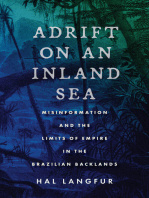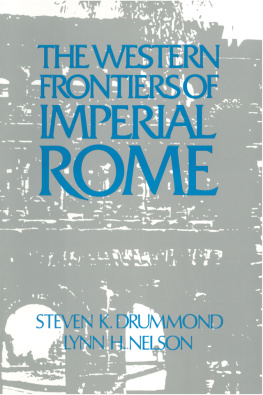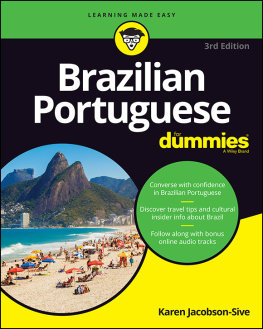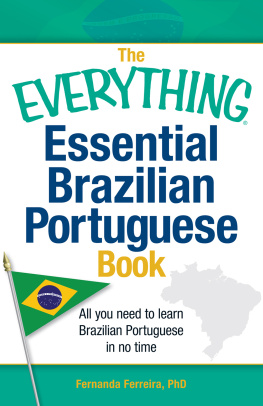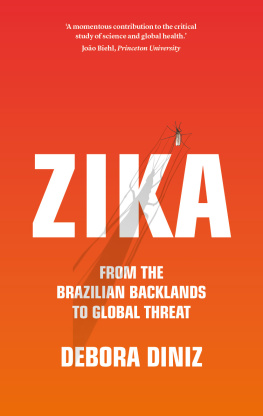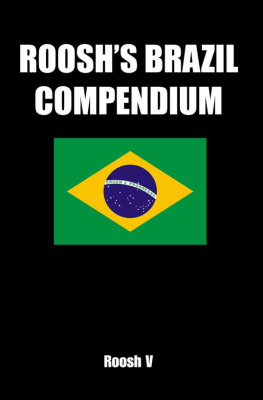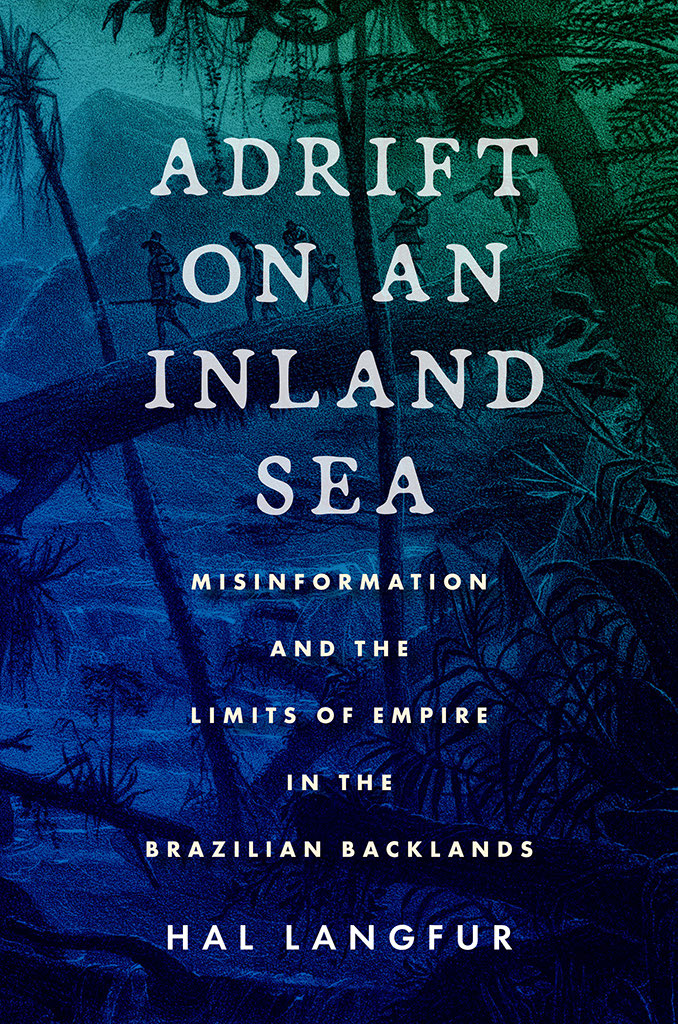
ADRIFT ON AN INLAND SEA
Misinformation and the Limits of Empire in the Brazilian Backlands
Hal Langfur
STANFORD UNIVERSITY PRESS
Stanford, California
STANFORD UNIVERSITY PRESS
Stanford, California
2023 by Hal Langfur. All rights reserved.
No part of this book may be reproduced or transmitted in any form or by any means, electronic or mechanical, including photocopying and recording, or in any information storage or retrieval system without the prior written permission of Stanford University Press.
Printed in the United States of America on acid-free, archival-quality paper
Library of Congress Cataloging-in-Publication Data
Names: Langfur, Hal, author.
Title: Adrift on an inland sea : misinformation and the limits of empire in the Brazilian backlands / Hal Langfur.
Description: Stanford, California : Stanford University Press, 2023. | Includes bibliographical references and index.
Identifiers: LCCN 2022010220 (print) | LCCN 2022010221 (ebook) | ISBN 9781503632844 (cloth) | ISBN 9781503633964 (paperback) | ISBN 9781503633971 (ebook)
Subjects: LCSH: MisinformationBrazilHistory18th century. | MisinformationBrazilHistory19th century. | BrazilHistory17631822. | PortugalColoniesAmericaAdministration.
Classification: LCC F2534 (print) | LCC F2534 (ebook) | DDC 981/.032dc23/eng/20220926
LC record available at https://lccn.loc.gov/2022010220
LC ebook record available at https://lccn.loc.gov/2022010221
Cover design: Rob Ehle
Cover image: Virgin Forest: Banks of the Paraba River. Source: Jean Baptiste Debret, Voyage pittoresque et historique au Brsil (Paris: Firmin Didot frres, 1834), vol. 1. Courtesy of the John Carter Brown Library. Licensed under CC-BY 4.0.
Typeset by Newgen North America in 10/15 ITC Galliard Pro
For Kerry, Bridger, and Devon, my anchors
CONTENTS
ILLUSTRATIONS
Map
Figures
ACKNOWLEDGMENTS
THIS BOOK CONCERNS HOW colonizers and those they sought to control wielded information in the distant past. Completing it at a time when the manipulation of what is known and unknown has become so problematic, I feel especially grateful for the many professional and personal relationships built on trust that have sustained this project over many years.
Research and writing were made possible by the generosity of various institutions and fellowship programs. A Fulbright research and teaching fellowship based at the Universidade Federal de So Joo del-Rei (UFSJ) in Minas Gerais, Brazil, gave an essential push to the project at its inception. The University at Buffalo (UB), my home institution, provided two sabbatical leaves and a research fellowship from its thriving Humanities Institute. Further support came from the Newberry Library, which hosted me as a National Endowment for the Humanities Fellow, and the John Carter Brown Library, where I was the R. David Parsons, Donald L. Saunders Research Fellow. At more than twenty archives, most of them underfunded, dedicated staffs made the hunt for sources rewarding on three continents.
Of the numerous debts incurred to those who took an interest in this study, I am able to describe only a few in any detail. In my own department Erik Seeman has been unwaveringly eager to read portions of the manuscript, offer incisive commentary as a fellow Atlanticist, and extend his valued friendship. Laura de Mello e Souza, now at the Sorbonne, first alerted me to the far-reaching possibilities of examining forgotten eighteenth-century expeditions to the sertes (backlands) as important social, cultural, and political phenomena. Although our paths have crossed infrequently, her work has been a constant source of inspiration. The late John Monteiro encouraged an entire generation of scholars to take up the challenge of centering Native peoples in Brazils colonial history. He helped deepen my understanding of the sertes as contested territory, a premise that applied even as this study extended to include peoples of African descent. I was privileged to co-teach a course in Indigenous history at UFSJ with Maria Lenia Chaves de Resende. Her knowledge as a historian and openheartedness as a friend proved decisive at key moments. Lenia, along with Pedro Cardim, ngela Domingues, Pablo Ibaez Bonillo, and others associated with the Centre for the Humanities (CHAM) at the Universidade Nova de Lisboa, unrivaled as a collaborative environment for scholars of the Lusophone world, invited me on several occasions to present my research in progress. The Luso-American Development Foundation funded one of these visits. Cynthia Radding and Danna Levin Rojo welcomed me into the remarkable international cohort of scholars they assembled for two colloquia that resulted in The Oxford Handbook of Borderlands of the Iberian World (2019). Chapters 3 and 5 herein include portions of a text that appeared in their edited volume. Mark Harris and Silvia Espelt-Bombn hosted a similarly productive workshop at the University of St. Andrews, leading to a dedicated issue of Ethnohistory (October 2018) on Amerindian spaces in Brazilian history. Parts of my contribution to that collection have been reworked and refocused in chapter 9. Oxford University Press and Duke University Press kindly granted permission to republish this material.
For engaged criticism, invitations to present research, and other forms of academic and personal generosity in the United States, Brazil, and Portugal, I also wish to thank Camilo Trumper, Dalia Antonia Caraballo Muller, Ndubueze Mbah, Victoria Wolcott, Jonathan Dewald, David Castillo, Henry Berlin, Carine Mardorossian, David Alff, Richard Graham, Sandra Lauderdale Graham, Carlos Rodriguez, Brian Bockelmen, Len Garca Garagarza, Amy Turner Bushnell, Neil Safier, Mary Karasch, Judy Bieber, Heather Roller, Sebastin Daz Angel, Surekha Davies, Fabrcio Prado, Chi-ming Yang, Ana Hontanilla, Lisa Voigt, Mariana Dantas, Ray Craib, Alison Bigelow, Lauren Benton, Gabriel de Avilez Rocha, Yuko Miki, Kris Lane, Tamara Walker, Dain Borges, Kenneth Mills, James Green, Alida Metcalf, Susan Sleeper-Smith, Izabel Missagia de Mattos, Luciano Raposo, Jnia Ferreira Furtado, Mrcia Motta, Marina Machado, Valter Sinder, Vania Belli, Andra Dor, Belmiro Nascimento, Carmen Alveal, Eduardo Frana Paiva, Maria Regina Celestino de Almeida, Alton Krenak, Ricardo dos Anjos, Rodrigo Bentes Monteiro, Joo Pacheco de Oliveira, Cristina Brito, Pablo Snchez Len, Nina Vieira, Andr Morgado, and Tiago C. P. dos Reis Miranda. Students in my graduate seminar on frontiers and borderlands read a draft, offering helpful suggestions.
With reassuring enthusiasm, expertise, and efficiency, Margo Irvin took on this project at Stanford University Press, ably assisted by Cindy Lim, Tiffany Mok, and others. Barbara Sommer and Kirsten Schultz read the manuscript for the press with meticulous care, each sharing insights that improved the final version. Erin Greb produced the map, Dawn Hall applied her precise pen as copyeditor, and Kate Mertes constructed the index..
Friends, family, and fellow musicians kept things in perspective and sustained me even when the project slowed, especially Bob Campbell, Tom and Peg Sullivan, David and Sigrid Fertig, Joe and Jen Mattimore, Jo and Dick Sanders, the entire Reynolds clan, Maleeka Manurasada, and David Nicholson. My wife Kerry Reynolds read the full manuscript with a perceptive eye. She held me in her heart at every turn, as did my children Bridger Langfur and Devon Reynolds, as do I them, in the end the achievement that matters most. To these beloved three, I dedicate this book.
Next page
